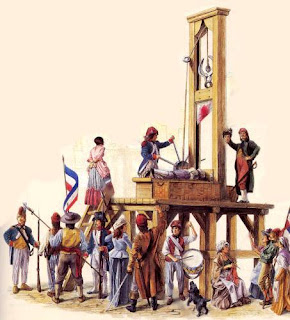Bleed Me, Purge Me
 |
| Apothocary Shop in Paris, France |
Still, becoming sick in 18th century France was frightening and often fatal. Smallpox, tuberculosis, typhus, measles, cholera, and child birth accounted for many of the deaths, while medical mismanagement accounted for even more deaths.
 |
| 18th C. Cupping Implements |
"The way that menstruation was seen during the 1700s was as a way of the body to get rid of impurities. So when menstruation ceased during menopause, what was thought to happen was that the blood remained within the body, clotting and stagnating ... The logical solution was the application of leeches — to a woman's genitalia, to her back, or to the nape of her neck, to try and remove this excess blood." (Dr Marilys Guillemin, Menopause Myths and Medicine)
 |
| Weeping, praying, and tending to the sick. |
Smallpox
Smallpox was the dark cloud that hung over the world in the 18th century. The hospitals were littered with corpses, their bodies marked with tell-tale lesions. Smallpox did not discriminate, rather it struck at the young and old, the rich and the poor. Even royal beings were not immune. Empress Maria Therese, Antoinette’s mother, had a bout with smallpox in 1767 that weakened her heart and left her face marred with pits. Antoinette's sister, Elizabeth, had her beauty "disasterously and permemantly marred by the marks of smallpox." (To The Scaffold by Carolly Erickson
Louis XV of France died of smallpox in 1774. (Louis and Antoinette, Cronin and Annals of Internal Medicine, 15 October 1997, Nicolau Barquet)
Later that year, Marie Antoinette suffered from a mild form of the disease and Louis XVI was inoculated, a new a practice which most viewed with great skepticism.
Did you know that Madame de Sevigne, Mary Queen of Scots, Elizabeth I, George Washington, and Abraham Lincoln suffered from bouts with smallpox? Did you know that Louis XIV lost his eldest son to the disease?
And did you know that the brilliant Voltaire and Marie Therese (Marie Antoinette's mother) were proponents of the smallpox vaccine?
Childbirth
 |
| The birth of the dauphin |
The Queen's Health
"Her health was not robust. She had a weak chest, for which she had to drink ass's milk, and even in summer easily caught cold and sore throats. She was deficient in iron but could not stomach the iron-rich foods prescribed for her," so writes Vincent Cronin about Marie Antoinette in his book Louis and Antoinette
Marie Antoinette also suffered from a mysterious illness in 1776. She developed a high fever, took quinine, and lost most of her hair. While imprisoned and execution, the queen would suffer from painful and copious menses.
Although there were hospitals in Paris in the late 18th century, they were often unsanitary and overcrowded. Oftentimes, patients had to double-up in the beds. When one patient would die, he would be carried out and another would be moved in his place.


Absolutely fascinating! I love to read about history factoids such as those, and your brilliant writing makes it just that more enjoyable. I have added two of the books you referenced in my wish list :)
ReplyDelete